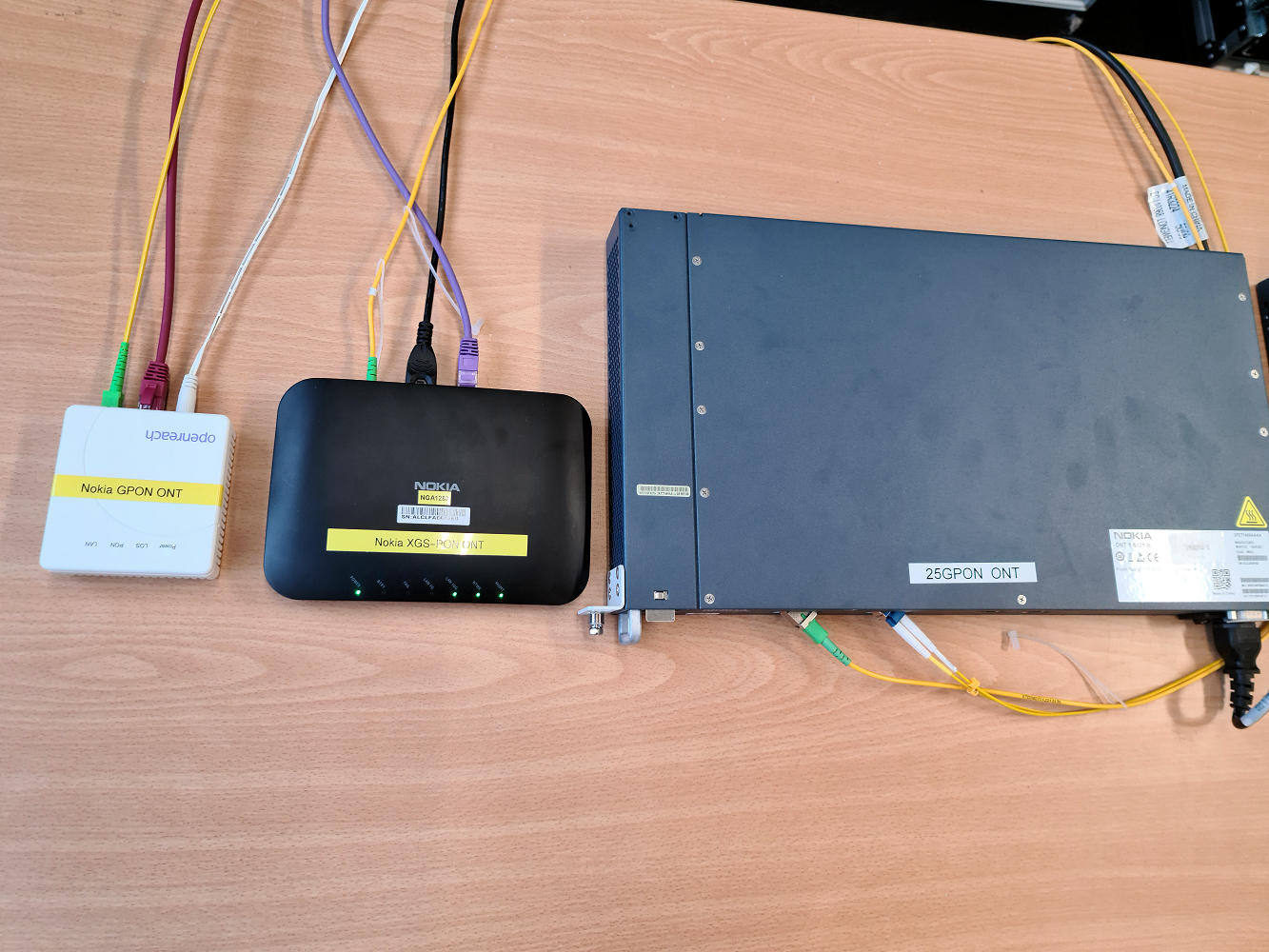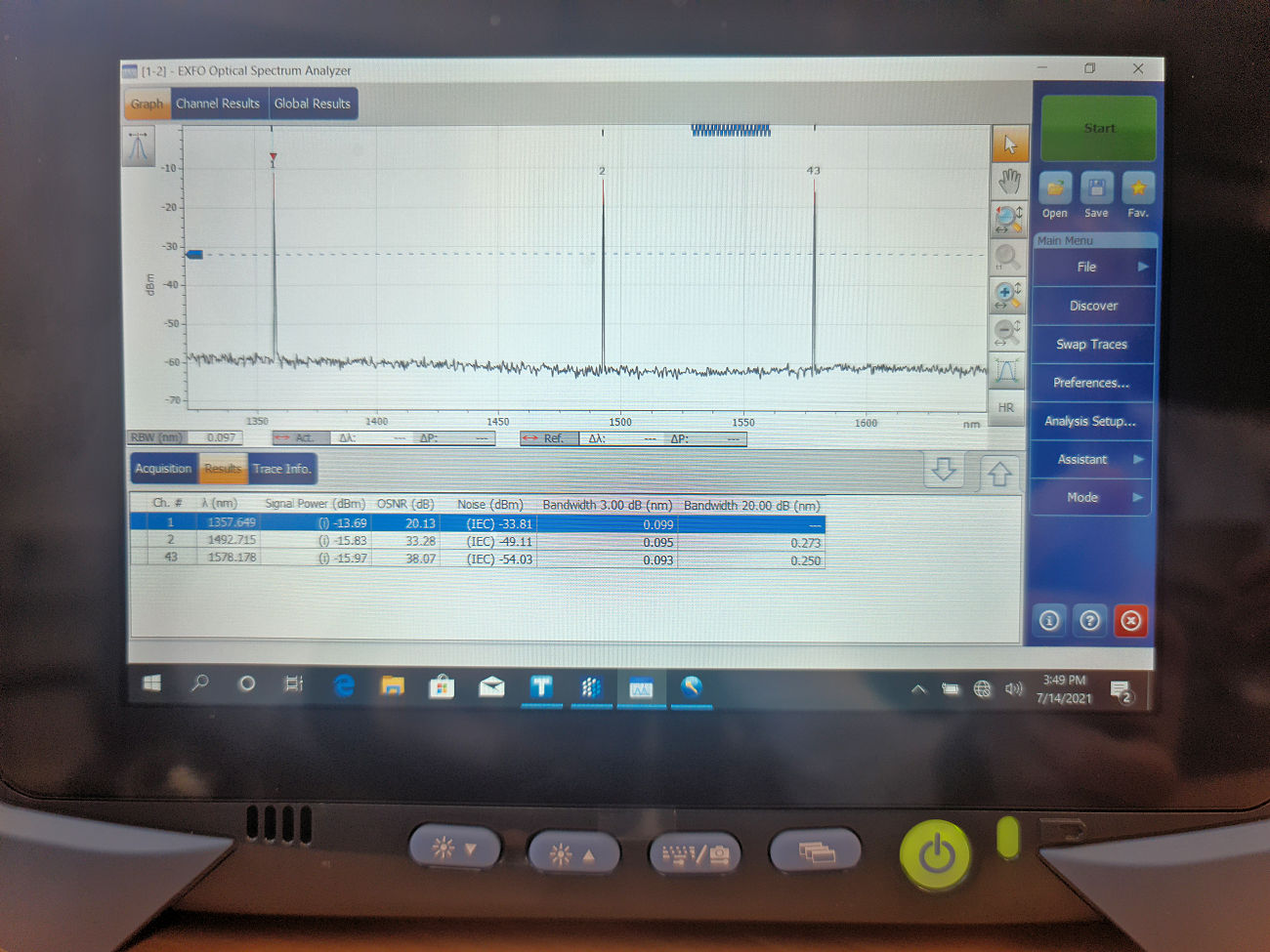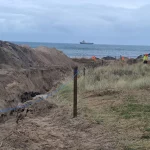Openreach in First UK Trial of Nokia 25Gbps FTTP Broadband Kit

Network access provider Openreach (BT) has this morning announced that they’ve conducted the UK’s “first ever” tests of Nokia’s new next generation 25G PON technology, which has the ability to push download speeds of 25Gbps (Gigabits per second) over a single optical fibre and could one day result in faster FTTP speeds from ISPs.
We first covered the emergence of symmetric speed 25G PON technology in November last year (here), which is often regarded as the next step in Passive Optical Network evolution. Back then Nokia said that the new technology can “co-exist with GPON and XGS-PON on the same infrastructure [this requires no changes to the outside plant], allowing [ISPs] to add 25Gbps in overlay without disrupting existing customer services.”
Openreach are of course already using kit from Nokia (and others like ADTRAN) to help underpin the rollout of their new Fibre-to-the-Premises (FTTP) broadband network for ISPs (here), which currently covers 5 million UK premises (homes and businesses) and is aiming to reach 25 million by December 2026 (at a cost of c.£15bn).
Advertisement
However, at best the existing hardware is more intended to support 1Gbps and up to 10Gbps services, although capacity constraints and the limits of existing kit mean that residential consumers on Openreach’s network aren’t likely to see speeds of above 1Gbps for quite awhile (improving national fibre coverage is currently far more important).
Nevertheless, eventually it will become necessary to go beyond 1Gbps and that’s where 25G PON could come in handy. So far Openreach and Nokia have only conducted lab tests of this at their Adastral Park facility in Ipswich, but the plan is to launch a full field trial in December 2021. You can see an example of their test kit below.
ONTs that go into the customer’s home or office
(Left to Right – GPON, XGS-PON and experimental 25G PON)

Advertisement
The focus of their future field trials will be to test compatibility with existing technologies (i.e. their 2.5Gbps GPON and 10Gbps XGS-PON services – that’s shared capacity from the PON), although the eventual goal is to offer both faster speeds and also the ability to “upgrade customers quickly, smoothly and without any disruption.”
Peter Bell, Director of Network Technology at Openreach, said:
“As the country’s largest digital infrastructure provider, it’s crucial that we continue to plan, innovate and evolve our network, to make sure we have the capacity and capabilities that the UK needs in the future.
The Full Fibre network we’re building today is going to be the platform for the UK’s economic, social and environmental prosperity, and these trials prove that we can keep upgrading the speeds and services our customers experience over that network for decades to come.”
Sandy Motley, President Nokia Fixed Networks, said:
“The key to unlock the virtually unlimited capacity that fibre offers is to develop new generations of fibre technology – and faster chips. Nokia’s Quillion chip allows us to have a solution that supports three generations of PON technology from a single platform that is already in the Openreach network.
Having GPON, XGS-PON and 25GS-PON all on the same fibre means Openreach can efficiently evolve the network capabilities, address new opportunities and connect more consumers, businesses and 5G cell sites.”
Nokia said they expect 25G speeds to be used by operators to extend their Full Fibre networks beyond residential use into enterprises. The technology can even be used by operators for 5G backhaul, which becomes important as 5G networks become pervasive and require small cells to be deployed in areas of dense traffic.
All of this is great to see, although as we say, it’ll probably be a little while longer before residential connections see speeds of faster than 1Gbps on Openreach’s network. On top of that, we have our doubts about the ability to receive speeds above 1Gbps “without any disruption,” since such an upgrade may require replacement of the ONT on your internal wall, among other things.
Screen grab of an optical spectrum analyser from the 25G PON test
(shows the 3 wavelengths all existing on a single fibre)
Advertisement

Mark is a professional technology writer, IT consultant and computer engineer from Dorset (England), he also founded ISPreview in 1999 and enjoys analysing the latest telecoms and broadband developments. Find me on X (Twitter), Mastodon, Facebook, BlueSky, Threads.net and Linkedin.
« 4,600 Gloucester City Homes Added to CityFibre’s FTTP Rollout
BDUK Consults on Gigabit Broadband Coverage in Cornwall UK »























































Excellent.
Might be able to reduce my connection count down from 3 while keeping the 2.1 Gbit/s download and considerably increasing the 260 Mbit/s upload.
Dear Openreach: bring it to me. Will pay for 5G or 10G symmetric.
25Gbps while many can’t get 25Mbps…
In fairness to OR and others this is being changed about as fast as it could be.
Technological evolution does not wait for the slowest areas to catch-up before moving forward. If it did, we’d all still be stuck on ADSL Max. As A_Builder says, Openreach and the rest of the c.90 operators building FTTP are currently doing so at an incredible pace, but when you build a new infrastructure you always have to keep one eye on tomorrow’s demands so that you aren’t caught out when tomorrow becomes today.
I should add, in case it wasn’t obvious, that when we talk about 25Gbps above we’re talking about shared capacity from the PON. Residential consumers on Openreach aren’t likely to get 25Gbps packages from this, but speeds like 10Gbps+ do become much more viable and possibly at symmetric style speeds.
BT can only offer 2 mbps in my new home! I have resorted to using Starlink, which is great for streaming but can be rather frustrating when using Citrix to work or when online gaming. It’s also very expensive, £89 per month!
I’m crossing my fingers that one day those of us in rural areas get a significant upgrade, by upgrade I mean 1 gig minimum just like the rest of the country in the not too distant future.
Out of curiosity Sean, did you not factor in broadband infrstructure into your decision on homes?
I’m looking to move but will not entertain areas that do not have FTTP built or build that isn’t already underway.
I’m not sure what the first image in the story is.
Does the 25GS-PON kit also support GPON & XGS-PON directly, or does there need to be an separate optical splitter to direct the various wavelengths to different OLTs dedicated to GPON / XGS-PON etc.
The first image looks like a co-existence element, (potentially also combined with a splitter) to support multiple technologies on the same network. This is a special filter/combiner that takes in the different connections from different OLT ports (or different OLTs), GPON, XGSPON and 25GPON and combines them down the single fibre that goes out to serve the network of 32, 64, 128 etc ONT’s installed at the end locations on that fibre. In the image it looks to be a 25G input and XGS input which is then combined and output on the blue connection. (If its a 16 way splitter it will actually send the combined signal out all 16 of those ports)
Multiple technologies will then be present on the fibre at each home/locations, but the ONT installed will just talk with the correct wavelength/technology it sees on the fibre that its designed for. GPON ONT will talk GPON, XGS will talk XGSPON, 25G ONT will talk 25G PON etc.
In the US, Utopia Fiber in Utah are pushing 4 terabits a second down a single fibre to link mini exchanges and data centres together.
The way it works is multiple fibres are connected into a panel and each fibre sends a different colour. All those colours are then combined into a single colour and sent down a single fibre. At the other end the machine separates all the colours again and sends them back down multiple fibres.
This shows what can be done as Utopia customers can get a 1gb/s, 10gb/s or 100gb/s connection.
Here is a really good video from Snazzy Labs on Youtube all about it:- https://www.youtube.com/watch?v=2e9DNwInTE4
You can buy 1, 10 and 100Gbps services in the UK too, but not at broadband prices.
You’ll be spending the best part of £40k on a router than can handle 100Gbps so a few grand a month on rental isn’t your primary problem.
WDM and DWDN don’t only exist in the US. These aren’t residential broadband technologies though. I can quite easily order either a wavelength or an entire bundle of dark fibre at essentially any speed providing i’ve got the equipment to put at both ends of the link, or I can just order 1/10/100 gig from a provider. It’s not quite the same thing ordering lines from a data centre to providing 25Gbps GPON shared out between however many homes have whatever speed they subscribe to. GPON is a shared medium, dark fibre and 100G links between DCs is 1to1 and not shared with anyone else usually (unless you order a wavelength, but then that specific wavelength is yours, you just share the fibre)
> Utopia Fiber in Utah are pushing 4 terabits a second down a single fibre to link mini exchanges and data centres together.
That’s called Wave Division Multiplexing and has been around for years. BT almost certainly use it in their core network.
You can buy 10G and higher leased line services in this country too, but not at consumer-friendly prices. That’s because these services are priced for someone who actually *uses* that much bandwidth 24×7.
Consumer lines are idle for most of the time, with occasional bursts. Averaged over 24 hours, typical usage is something like 1-3Mbps.
Every single provider who owns their own transmission / fibre network uses it, putting fibre in the ground is the expensive part. Running multiple wavelengths makes much greater use of that investment. The idea that it’s some sort of amazing new technology is laughable. Current speeds you’ve got something like 200 to 400 Gbps per wavelength.
These products are relatively old technology in technical terms and have been products on the UK market for years.
Also the main reason for why leased lines is expensive is the SLAs. If my FTTP connection goes down or starts dropping packets, it’ll be a while before it gets looked at, and there’s a lot of failures they can say “too bad, sucks to be you”. With a leased line if there’s any congestion, or packet loss, or it’s down that’s an issue that needs solving now.
A customer doesn’t have to be using it 100% every hour of every day, but as you touch on with your comment that is baked into the SLA of the product, so the network has to be able to cope with the customer’s usage pattern. Now in reality you don’t provision your entire network as the sum of leased lines – if I had 100 customers with 1Gbps leased lines at an exchange it doesn’t follow I have to purchase 100Gbps links because customers don’t all use at the same time. I might be able to get away with say 4 x 10Gbps, but obviously capacity management have to be on the top of the game to stop this ever becoming an issue.
It’s a similar principle with home broadband. On well provisioned networks you can use your line at full capacity whenever you want because statistically enough people are not using theirs to cope, however you have no automatic right to full speeds.
And even this said, you can end up with cases like Virgin Media not provisioning their networks well causing peak time congestion in areas. In terms of contractual SLAs the law is probably on their side, but when your competitors offer better service then the reality is “too bad” isn’t really an acceptable answer. Legally you can say it and there’s little comeback, but when it comes to keeping a happy customer base that doesn’t walk away, that’s a different story.
Would be great if they actually deployed XGS-PON
I can see why its not particularly urgent, most people will never get close to needing gigabit speeds so OP are focusing on getting it to more people. If you need higher than they offer leased lines. Going from GPON to XG PON isn’t too much work as all the fibre can be reused but their backhaul will likely need an upgrade.
I too question the “without disruption” quote. Whilst it is obvious there will be individual customer disruption as a result of ONT upgrades for customers who want the improved speeds, there will also presumably be a brief (5 min) outage on the whole PON whilst a suitable multiplexing filter is installed / replaced in the optical distribution frame.
Whilst it is noted from that Openreach video from a few weeks ago that they are already installing multiplexing filters, it would be interesting to see their specifications. Unless they only accept GPON on one port and accept everything but GPON on the other then there is no guarantee that they’ll be compatible with the frequencies used for 25G.
PS: There should be six frequencies on that spectrum analyser trace – GPON, XGS-PON and 25G-PON, both up and down.
The ‘multiplexer’ is a passive device and they are already there waiting on future use.
The spectrum analyser is showing forward paths, not returns.
Probably will see some outage but likely just a software upgrade to the OLTs, then just a replacement of ONT.
I’m expecting the multiplexer to be frequency specific for minimum loss – I doubt it is simply a splitter. Unless it is a specifically designed to mix GPON with *anything* else (i.e. notch on one port, bandpass on the other) then whether it is compatible will depend on what it was designed to be compatible with.
The point with the spectrum analyser plot is that you can’t show coexistence (which is what the article implies was shown) unless you look at both upstream and downstream.
The OLT will be new optics which essentially means a new OLT or replacement cards for your existing one (probably the former as the old one may not have the backplane bandwidth to support the higher speed).
Difficult to tell whether multiple PON technologies will get integrated into a single OLT in the field. You can buy that now, but until you’ve settled on what the next PON technology will be (10G, 25G, 50G?, something else? BT clearly haven’t decided) then there isn’t much point.
Planning to integrate multiple technologies on a single OLT also makes the installation of the multiplexers in the distribution frame pointless. Their presence suggests that BT see the future as having different OLTs for different technologies.
Yep you’re right and I’m wrong. The co-existence elements do have filtering.
OLTs currently do not support multiple PON standards on the same port. They rely on the carrier combining fibre outputs from separate OLT ports. Whether additional OLTs or additional line cards the new hardware will be in addition to, not instead of, so perhaps firmware upgrades on OLTs to take the new line cards other than that new kit.
Thank you to you and another poster for the correction.
The article didn’t mention what PON standard this was meant to demonstrate, but the downstream 25G wavelength shown in the spec-an photo above is for the 25G-EPON (802.3ca) standard.
Most of the PON deployed this side of the pond (or indeed globally) isn’t EPON but rather ITU-T standards based PON that is G-PON and latterly XGS-PON
Does this mean OR have been convicted by Nokia that EPON is now the go to choice or simply that Nokia haven’t developed silicon (yet) for the 50G-PON ITU-T standard which is due to be ratified this year?